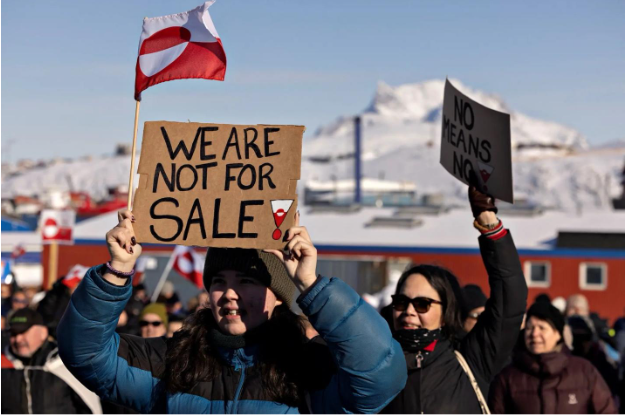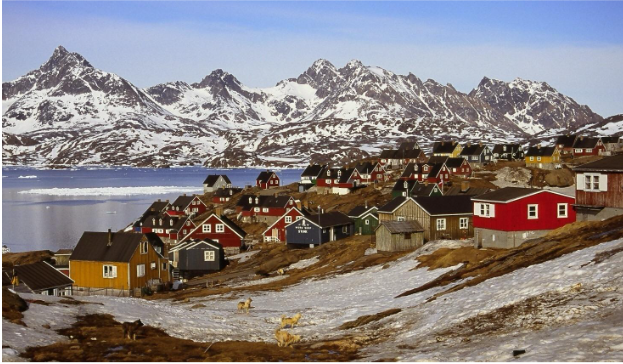From Monopoly to Minerals: Greenland’s Journey Between Denmark, the EU, and the U.S.
By: Lavinia Tacke
Reading time: 5 minutes
protests in Greenland, picture source: https://www.nytimes.com/2025/04/10/us/politics/trump-greenland-denmark.html
In the wake of US President Donald Trump’s interest in Greenland, the world’s largest island has recently become one of the central topics in global media discourse. But what makes Greenland so unique and how did the island become what it is today?
Greenland, Denmark, and the European Union
Greenland is largely an autonomous political territory that belongs to the Kingdom of Denmark. The relationship between Denmark and Greenland has a long and complex historical foundation. During the 18th century, Denmark colonized the Arctic island and “assumed a full monopoly of trade” while restricting foreign access. During the colonial era, Denmark implemented a “protectionist policy”, effectively isolating Greenland from the rest of the world. Greenland remained a Danish colony until it was formally integrated into Denmark in 1953, thereby acquiring political representation in the Danish parliament. However, Greenland’s political autonomy remained constrained.
Following Greenland’s incorporation into the Kingdom of Denmark, the island became part of the European Union in 1973, despite limited public support for accession. In response to growing resistance among Greenlanders towards Danish political dominance, the so-called “home rule” was established in 1979, significantly reducing Danish influence.
Subsequent to this development, Greenland left the European Communities in 1884 as the first territory to ever leave the Union. Greenland’s autonomy was further reinforced in 2009 with the enactment of the Act on Greenland Self-Government, which expanded Greenland’s self-governance and recognized the Greenlanders “as a People pursuant to international law with the right to sovereignty”. Despite the loosening of Greenland’s ties to Denmark, the Greenlandic people remain dependent on Denmark for financial support and for Danish decision-making in fields such as, “foreign policy, defense policy, and security policy”.
American Interest in Greenland
The United States’ interest in Greenland is not a recent development. US-Greenlandic history can be traced back to nearly 200 years ago, with the implementation of the Monroe Doctrine in 1823. In the Monroe Doctrine the then-President James Monroe articulated the United States’ territorial interests in Greenland and advised the European states to not interfere in their sphere of interest which, according to him, included Greenland, for the island is geographically part of North America.
During the German occupation of Denmark in the Second World War, the Greenlandic-Danish contact was completely severed. In this period, the United States assumed de facto administrative control over Greenland and established military bases in the Arctic Region—some of which are still operational to this day.. As radical as President Trump’s vows to acquire Greenland “one way or another” appear, the American interest in purchasing the island is far from new.
The American military base “Pituffik Space Base”,
Picture source: https://apnews.com/article/greenland-american-military-pituffik-space-base-denmark-746d67b1bc8e6681328a809787412495
A review of historical records reveals that the United States has previously expressed interest in acquiring Greenland. For instance, in 1946, shortly after the Second World War, the Truman administration sought to purchase the Arctic territory for "the equivalent of $1 billion."
The United States’ interest in acquiring Greenland is mainly rooted in its richness of natural resources, such as lithium and titanium, which are crucial components in the manufacturing of phones and other advanced technologies. According to the USC Dornsife, the natural resources found in Greenland are of particular interest to the United States, especially in the context of its economic competition with China.
Secondly, Greenland’s “geostrategic location” reinforces the US interest. The island's strategic importance for the United States stems from its position within a critical maritime route known as the Greenland-Iceland-United Kingdom (GIUK) gap, which facilitates the movement of submarines and naval vessels.
As history shows, Donald Trump is not the first US-President that showed interest to acquire the Arctic Island. But they are by far not the only state interested in increasing their influence on Greenland. According to the New York Times, “Canada, Europe, China and Russia all have interests in the Arctic, its geostrategic position and its natural resources”. In Greenland Trump’s plans have not induced agreement. Shortly after Trump’s first speech to the congress the Greenlandic politician Aqqaluk Lynge stated: “We own this country. We own the resources. We own everything.”


